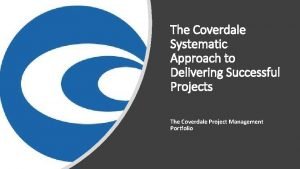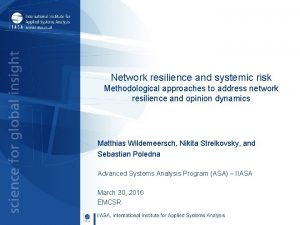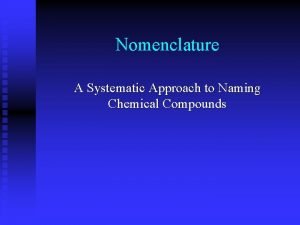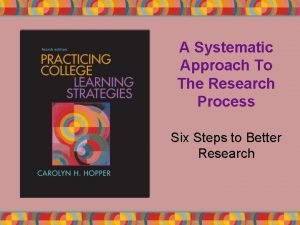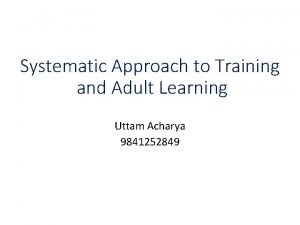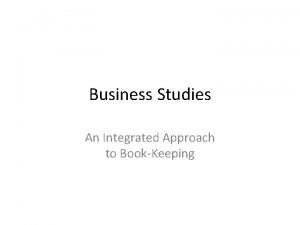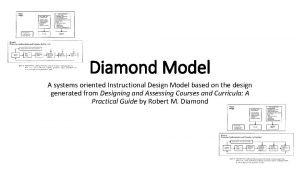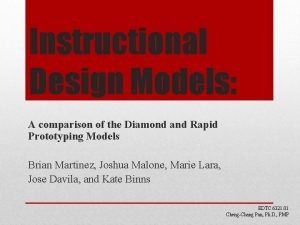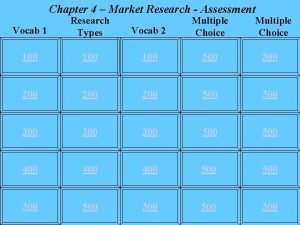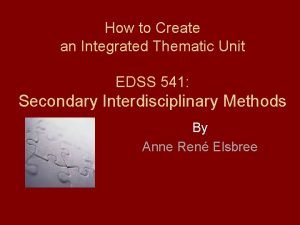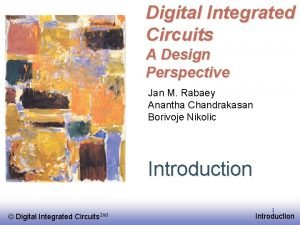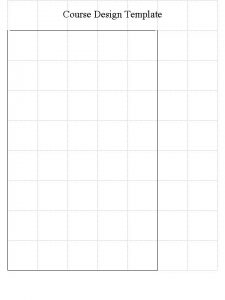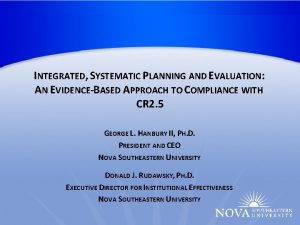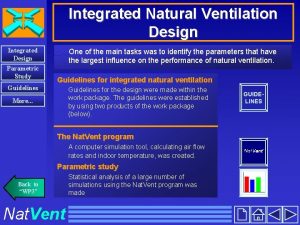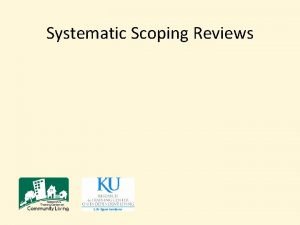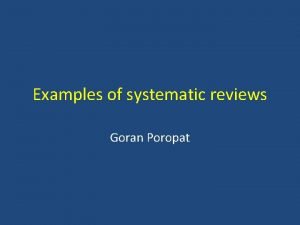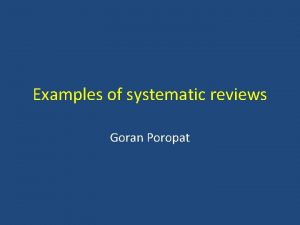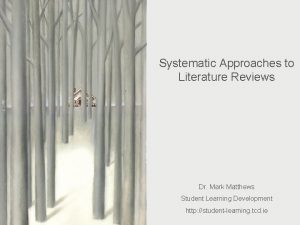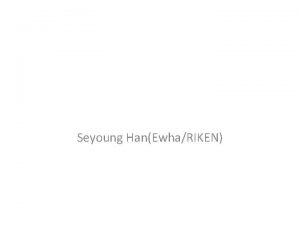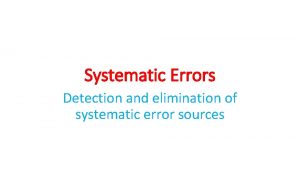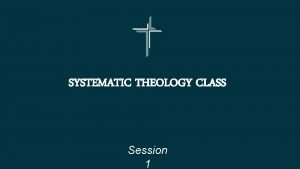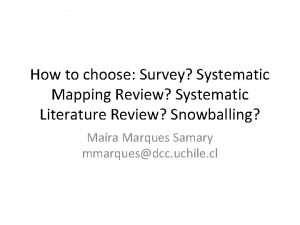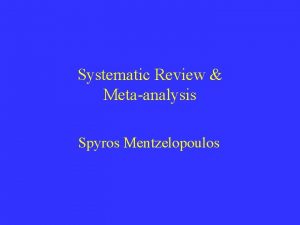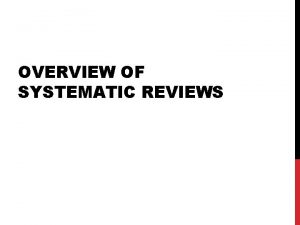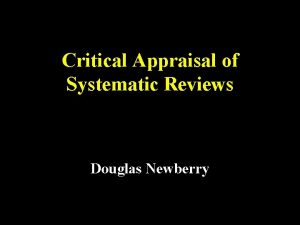Integrated Course Design A Systematic Approach Using Finks
























- Slides: 24

Integrated Course Design A Systematic Approach Using Fink’s (2003) Model

Your Questions n Take two minutes and write down the questions you have about course design n Share your questions: 1. 2. 3. 4. 5. 6. . .

Outcomes for Today 1. 2. 3. Answer most of your questions Learn about and apply a structured approach to course (re)design Using Blackboard and Turning Point features to your and your students advantage

Purpose of Course Design n Creating a practice plan to help students achieve high levels of performance n What do you want students to be able to do by the end of your class and beyond? n n Know your goals/outcomes and why are they important How are they related? n n Are they unique, singular? Can they be organized in a logical sequence?

How do you help them get there? Plan backwards:

Plan Backwards, Scaffold Forward: Sequence to Help Students Attain Learning Outcomes

Where Do You Start? Step 1 worksheet Important Situational Factors Identify the situational factors that significantly impact your course (5 min) n Share some factors n

Step 2 Worksheet Learning Goals (aka Outcomes, Objectives)

Join in Groups of Three Share 1 LO with partners

Review the LO Identify strenghts and weaknesses of the LO: n Is it focused on students being able to “do” something important next semester, 1 yr, 2 rs after your class? What is the long term value? n Is it written clearly and unambiguously in behavioral terms? n Where does if fit in Fink’s taxonomy (see worksheet)?

Fink’s. Taxonomy of Significant Learning (= Change) Learning How to Learn Caring Human Dimension • New concepts for describing learning • Non-hierarchical and interactive Foundational Knowledge Application Integration • These challenge our thinking about teaching, including teaching ethics • More effectively support design of student-centered learning and distance education Source: Creating Significant Learning Experiences, by L. Dee Fink

How do you know if students are achieving your Learning Outcomes? Step 3 worksheet The Necessity of Assessment

Assessment and Feedback A learner-centered, teacher-directed, mutually beneficial, formative, contextspecific, and ongoing investigation that is rooted in good teaching practice. It answers: How well are they getting it?

Two Levels of Students Assessment Both Should Occur 1. Formative assessments for feedback and practice n 2. Conducted frequently Summative assessment for grade n Conducted infrequently Share your Assessment with your Trio See Worksheet

Feedback and Assessment n Is it an authentic, forward-looking assessment? n Is the assessment valid What criteria/traits are key elements of the LO? n n Are they represented in the assessment? How does it distinguish good work from poor? n n What are your standards for each trait? n Is the assessment reliable? Is the assessment objective? n Do they get a chance to revise their work? n

How will the students receive feedback from you?

Formative Assessments: The Use of CATs 1. 2. 3. 4. 5. Find CATs that fit your learning outcomes Make assessment a useful and fun event Try a CAT before you ask your student to use it Allow for more time than you think you need to carry out the CAT and give feedback Make sure to “close the loop” and provide immediate feedback to students See Work Sheet

Step 4 Selecting and Delivering Effective Learning Activities (40 min) n n n What makes learning activities effective? Use the work sheet as a starting point to identify strategies Always incorporate reflection into the learning activity: What are you learning? n How are you learning? n n Why is what you are learning important?

Step 5 Worksheet Integrating the Main Components n Use the 4 -column table in the work sheet (Step 5) n Identify resources needed For class management (e. g. kitchen timer) n For learning activities: readings, internet sites, etc n Share your table with an experienced partner n Lay it out visually n

Step 6 Worksheet Thematic Structure n See worksheet

Basic Course Structure Step 7 -8 worksheet Done in Inspiration; see Inspiration. com

Structure Details for One Session Leverage Technology to help Students Prepare for Class and Teach to Their Needs

Second Class Session Following Class I

Wrapping It Up n n n Did I answer your questions? Did we meet the objectives? Please complete the evaluation form Thank You
 Coverdale systematic approach first step
Coverdale systematic approach first step Systematic approach to problem solving
Systematic approach to problem solving Network resilience a systematic approach
Network resilience a systematic approach Systematic approach to naming chemical compounds
Systematic approach to naming chemical compounds Systematic approach to research
Systematic approach to research Systematic approach to training
Systematic approach to training An integrated approach to business studies
An integrated approach to business studies The diamond model of curriculum development
The diamond model of curriculum development Instructional design models comparison
Instructional design models comparison Marketing research is the systematic design ____ of data
Marketing research is the systematic design ____ of data Half brick wall vs one brick wall
Half brick wall vs one brick wall Course title and course number
Course title and course number Course interne moyenne externe
Course interne moyenne externe Border security using wireless integrated network sensors
Border security using wireless integrated network sensors Datagram vs virtual circuit
Datagram vs virtual circuit Theoretical models of counseling
Theoretical models of counseling Waterfall approach vs shower approach
Waterfall approach vs shower approach Approach approach conflict
Approach approach conflict Cognitive approach vs behavioral approach
Cognitive approach vs behavioral approach Approach research meaning
Approach research meaning Diagram for traditional approach
Diagram for traditional approach Tony wagner's seven survival skills
Tony wagner's seven survival skills Integrated thematic unit
Integrated thematic unit Jan m rabaey digital integrated circuits
Jan m rabaey digital integrated circuits Digital integrated circuits a design perspective
Digital integrated circuits a design perspective
